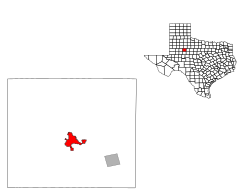Snyder, Texas
| Snyder, Texas | |
|---|---|
| City | |
 |
|
 Location of Snyder, Texas |
|
| Coordinates: 32°42′56″N 100°54′52″W / 32.71556°N 100.91444°WCoordinates: 32°42′56″N 100°54′52″W / 32.71556°N 100.91444°W | |
| Country | United States |
| State | Texas |
| County | Scurry |
| Area | |
| • Total | 8.6 sq mi (22.3 km2) |
| • Land | 8.6 sq mi (22.2 km2) |
| • Water | 0.0 sq mi (0.1 km2) |
| Elevation | 2,320 ft (707 m) |
| Population (2010) | |
| • Total | 11,202 |
| • Density | 1,300/sq mi (500/km2) |
| Time zone | Central (CST) (UTC-6) |
| • Summer (DST) | CDT (UTC-5) |
| ZIP codes | 79549-79550 |
| Area code(s) | 325 |
| FIPS code | 48-68624 |
| GNIS feature ID | 1347340 |
| Website | http://ci.snyder.tx.us/ |
Snyder is a town in, and the county seat of Scurry County, Texas, United States. The population was 11,202 at the 2010 census. The city is located in the lower part of the Southwestern Tablelands ecological region.
Snyder is named for merchant and buffalo hunter William Henry (Pete) Snyder, who built a trading post on Deep Creek in 1878. It soon drew fellow hunters and a small settlement grew up around the post. The nature of those early dwellings, mostly constructed of buffalo hide and tree branches, led to the communities first, if unofficial, name of "Hide Town". Another early name, "Robber's Roost" is said to owe its beginnings to the sometimes nefarious nature of a few residents and a lack of law enforcement. A statue of an albino buffalo on the grounds of the Scurry County courthouse in Snyder pays homage to the town's beginnings as a buffalo trading post.
Snyder predates Scurry County itself by two years, with a town plan being drawn up in 1882 while the county wasn't organized until 1884. A population of 600 was reported in 1892, with a school, two churches, a grist mill, steam gin, two banks and two weekly newspapers being part of the community. Significant change happened in 1907 when Snyder was granted a city charter, and construction began on the Roscoe, Snyder and Pacific Railway. The 1910 census indicated Snyder had grown to a population of 2,514. The Atchison, Topeka & Santa Fe Railway tracks reached Snyder in 1911, spurring further growth. Ranching and farming were the primary economic backbone of Snyder through the first half of the 20th century.
This changed in 1948 when oil was discovered in the Canyon Reef area north of town. Snyder became a boomtown as the population jumped to approximately 12,000 in just a year's time. By the time the boom ended in 1951 an estimated peak popularion of 16,000 had been reached. This soon decreased to the 10,000 to 11,000 level and stabilized. Although the boom was over, oil still remained a vital part of the local economy, with the Snyder area being one of the leading oil producing areas in Texas. In 1973 the one billionth barrel of oil was pumped from the nearby oil field.
...
Wikipedia
